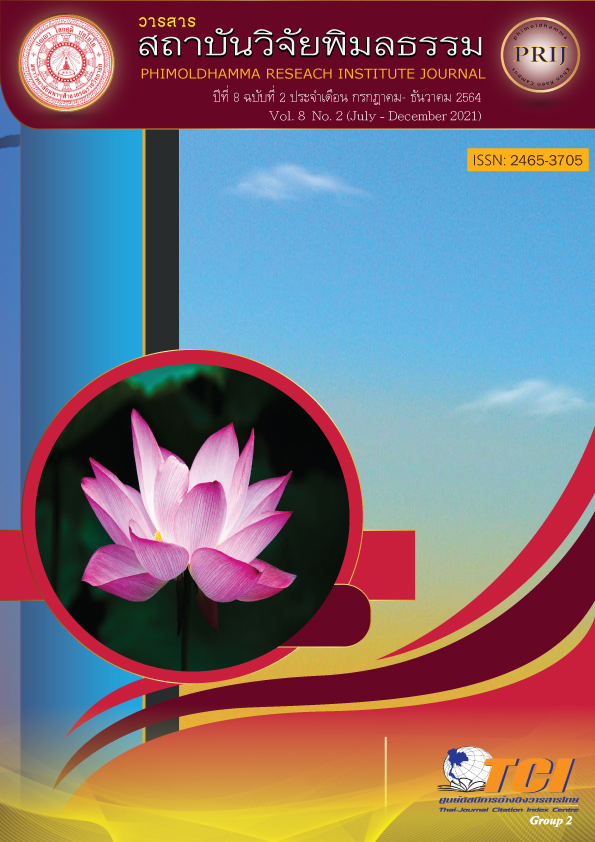Developing Analytical Thinking Ability and Achievement by CAI Lesson with Coding Program Based on Gagne’ Concept Computer level course for Grade 6 Students
Keywords:
Cai Lesson Based on Gagne’ Concept of Instruction to Be Used With A Coding Program, Analytical Thinking Ability, Learning AchievementAbstract
The objectives of this research were: 1) to develop a CAI lesson for a 6th grade computer subject based on Gagne’ concept of instruction and used a coding program for instruction so as to have an effectiveness criterion of 80/80, 2) to study the efficiency index of the CAI lesson for the 6th grade computer subject as developed, 3) to develop analytical thinking ability of 6th grade students in order that they made a total mean achievement score of 80 or higher and that 80% of the students pass the criterion and 4) to develop the students’ learning achievement in computer subject using the CAI lesson in order that they made a mean learning achievement score of 80% or higher and that 80% of the students passed the criterion. The pre-experimental research design of One-Shot Case Study was applied for data collection, and the sample consisted of 25 grade 6 students in Kalayanee Wittaya School who were selected through a cluster random sampling during the second semester of the 2020 academic year. The Research instruments included four categories of 1) a CAI lesson based on Gagne’ instructional concept to be used with a coding program, 2) 12 instruction plans on the computer subject which took 12 instructional periods to finish, 3) a 6-item essay test to evaluate the students’ analytical thinking ability and 4) a 30-item objective test with 4 choices for evaluating the students’ learning achievement. The collected data were analyzed by means of applying percentage, arithmetic mean and standard deviation.
The research results were as follows:
1. The effectiveness of the CAI lesson based on Gagne’ concept (E1/E2) was 80.16/83.47.
2. The efficiency index of the CAI lesson as developed was 0.5020 which proved that the students have made a learning progress of 50.20%.
3. The students showed a mean achievement score of 80.73% in analytical thinking ability, and 22 students or 88.00% of the group passed the prescribed criterion.
4. The students made a mean learning achievement score of 83.47% of the full marks, and 24 students or 96.00% of the group passed the prescribed criterion.
References
กรกนก สำกำปัง. (2551). การสร้างบทเรียนคอมพิวเตอร์ช่วยสอนเรื่อง สมบัติของวัสดุ และการทดสอบวัสดุ. กรุงเทพฯ: มหาวิทยาลัยเทคโนโลยีพระจอมเกล้าธนบุรี.
กิดานันท์ มลิทอง. (2543). เทคโนโลยีการศึกษาและนวัตกรรม. (พิมพ์ครั้งที่ 2). กรุงเทพฯ: อรุณการพิมพ์.
ชาญชัย แฮวอู. (2550). คอมพิวเตอร์ช่วยสอนวิชาตรวจสอบงานเชื่อมเรื่องการตรวจสอบแบบไม่ทำลายสภาพ. (วิทยานิพนธ์ครุศาสตรอุตสาหกรรมมหาบัณฑิต). กรุงเทพฯ: มหาวิทยาลัยเทคโนโลยีพระจอมเกล้าธนบุรี.
ถนอมพร เลาหจรัสแสง. (2550). นิยามเลิร์นนิงออปเจ็กต์ (Learning Object) เพื่อการออกแบบพัฒนาสื่ออิเล็กทรอนิกส์. วารสารเทคโนโลยีและสื่อสารการศึกษา มหาวิทยาลัยสุโขทัยธรรมาธิราช, 4(4), 50-59.
ทิศนา แขมมณี. (2555). บัณฑิตศึกษาในศตวรรษที่ 21: การปรับหลักสูตรการสอน. (เอกสารอัดสำเนา).
ธนาวุฒิ ขุมทอง, มนัส วัฒนไชยยศ และบรรจง ชลวิโรจน์. (2558). การพัฒนาคอมพิวเตอร์ช่วยสอน (CAI) ในรายวิชาเมโลเดียนเบื้องต้นของนักเรียนชั้นประถมศึกษาปีที่ 3 โรงเรียนสวนลุมพินี กรุงเทพมหานคร. วารสารมนุษย์สังคมสาร (มสส.), 15(2), 197-205.
มานะ โสภา และคณะ. (2560). การพัฒนาบทเรียนคอมพิวเตอร์ช่วยสอนตามแนวคิดของกาเย่ เรื่อง อุปกรณ์คอมพิวเตอร์เบื้องต้น ชั้นประถมศึกษาปีที่ 2. วารสารวิจัยมหาวิทยาลัยเทคโนโลยีราชมงคลศรีวิชัย, 9(1), 24-34.
วิลาวัลย์ ศรีซุย. (2551). ผลการจัดการเรียนรู้ด้วยวัฏจักรการเรียนรู้ 7 ขั้น เรื่องพืชรอบตัว กลุ่มสาระการเรียนรู้วิทยาศาสตร์ ชั้นประถมศึกษาปีที่ 4. (การศึกษาค้นคว้าอิสระศึกษาศาสตรมหาบัณฑิต). มหาสารคาม: มหาวิทยาลัยมหาสารคาม.
วัชระ เยียระยงค์. (2549). การพัฒนาบทเรียนคอมพิวเตอร์ช่วยสอน กลุ่มสาระการเรียนรู้การงานอาชีพและเทคโนโลยี เรื่อง ส่วนประกอบคอมพิวเตอร์สำหรับนักเรียนช่วงชั้นที่ 2. (วิทยานิพนธ์ศึกษาศาสตรมหาบัณฑิต). กรุงเทพฯ: มหาวิทยาลัยศิลปากร.
สมบัติ การจนารักพงค์. (2545). เทคนิคการสอนให้ผู้เรียนเกิดทักษะการคิด. กรุงเทพฯ: ธารอักษร.
อชิรกาญณ์ ดอกไม้. (2558). ผลการใช้บทเรียนคอมพิวเตอร์ช่วยสอนร่วมกับผังความคิด วิชาวิทยาศาสตร์ เรื่อง ร่างกายของเราที่มีต่อผลสัมฤทธิ์ทางการเรียน และความสามารถในการคิดวิเคราะห์ของนักเรียนชั้นประถมศึกษาปีที่ 6 โรงเรียนอนุบาลสมเด็จพระวันรัต. Veridian E-Journal, Slipakorn University, 8(2), 2306-2320.
เอกภูมิ ชูนิตย์. (2553). การพัฒนาบทเรียนคอมพิวเตอร์ช่วยสอนเรื่อง ทวีปเอเชีย ที่สรุปบทเรียนด้วยแผนที่ความคิดสำหรับนักเรียนชั้นมัธยมศึกษาปีที่ 2. (วิทยานิพนธ์ศึกษาศาสตรมหาบัณฑิต). กรุงเทพฯ: มหาวิทยาลัยศิลปากร.
Marzano, R. J. (2001). Designing a new taxonomy of educational objectives. Thousand Oaks, California: Corwin Press.





